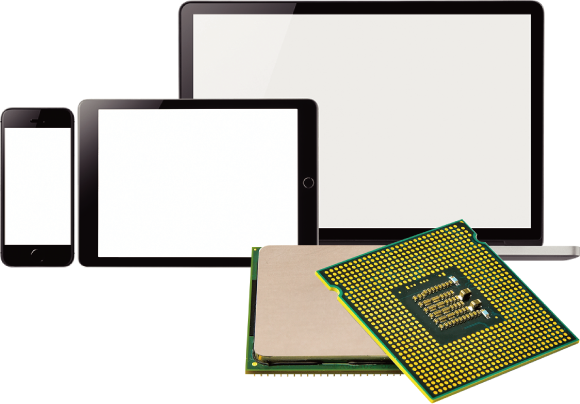Search for the LEX® you need
Various sizes and materials
to meet all needs

- Applications
- Semiconductors
Flat Panel Display-related manufacturing equipment, etc.
- Form of delivery
- Cast products, forged products (block shape),
3D printer formed products
- Material properties (example of measurement)
-
Classification:
Low carbon LEXProperties:
Zero expansion, low thermal expansion, forgeable
| Average coefficient of thermal expansion x ppm/℃ (10 to 40℃) | 0±0.19 | Expansion (%) | 28 |
| Lower limit of application temperature (℃) | -30 | Hardness (HB) | 137 |
| 0.2% yield strength (N/mm2) | 264 | Young’s modulus (GPa) | 133 |
| Tensile strength (N/mm2) | 378 | Thermal conductivity W(/ m・K) | 13.8 |
| Average coefficient of thermal expansion x ppm/℃ (10 to 40℃) | 0±0.19 |
| Expansion (%) | 28 |
| Lower limit of application temperature (℃) | -30 |
| Hardness (HB) | 137 |
| 0.2% yield strength (N/mm2) | 264 |
| Young’s modulus (GPa) | 133 |
| Tensile strength (N/mm2) | 378 |
| Thermal conductivity W(/ m・K) | 13.8 |
- *The above physical property values are for cast products.
- *Data other than the average coefficient of thermal expansion are examples of measurements and are not guaranteed.
- *Young’s modulus is measured using the bending resonance method.
- *Contents are subject to change without notice.

- Applications
- Semiconductors, optical parts, etc.
- Form of delivery
- Cast products, forged products (block shape)
- Material properties (example of measurement)
-
Classification:
Low carbon LEXProperties:
Super Invar (equivalent),
extremely low thermal expansion, forgeable
| Average coefficient of thermal expansion x ppm/℃ (10 to 40℃) | ≦0.8 | Expansion (%) | 30 |
| Lower limit of application temperature (℃) | -50 | Hardness (HB) | 133 |
| 0.2% yield strength (N/mm2) | 277 | Young’s modulus (GPa) | 128 |
| Tensile strength (N/mm2) | 372 | Thermal conductivity W(/ m・K) | 13.1 |
| Average coefficient of thermal expansion x ppm/℃ (10 to 40℃) | ≦0.8 |
| Expansion (%) | 30 |
| Lower limit of application temperature (℃) | -50 |
| Hardness (HB) | 133 |
| 0.2% yield strength (N/mm2) | 277 |
| Young’s modulus (GPa) |
128 |
| Tensile strength (N/mm2) | 372 |
| Thermal conductivity W(/ m・K) | 13.1 |
- *The above physical property values are for cast products.
- *Data other than the average coefficient of thermal expansion are examples of measurements and are not guaranteed.
- *Young’s modulus is measured using the bending resonance method.
- *Contents are subject to change without notice.

- Applications
- Semiconductor-related manufacturing equipment,
aerospace-related parts, etc.
- Form of delivery
- Cast products, forged products (block shape)
- Material properties (example of measurement)
-
Classification:
Low carbon LEXProperties:
Co1% or less, low thermal expansion, forgeable
| Average coefficient of thermal expansion x ppm/℃ (10 to 40℃) | ≦1.5 | Expansion (%) | 29 |
| Lower limit of application temperature (℃) | -196 | Hardness (HB) | – |
| 0.2% yield strength (N/mm2) | 198 | Young’s modulus (GPa) | 125 |
| Tensile strength (N/mm2) | 340 | Thermal conductivity W(/ m・K) | – |
| Average coefficient of thermal expansion x ppm/℃ (10 to 40℃) | ≦1.5 |
| Expansion (%) | 29 |
| Lower limit of application temperature (℃) | -196 |
| Hardness (HB) | – |
| 0.2% yield strength (N/mm2) | 198 |
| Young’s modulus (GPa) |
125 |
| Tensile strength (N/mm2) | 340 |
| Thermal conductivity W(/ m・K) | – |
- *The above physical property values are for cast products.
- *Data other than the average coefficient of thermal expansion are examples of measurements and are not guaranteed.
- *Young’s modulus is measured using the bending resonance method.
- *Contents are subject to change without notice.

- Applications
- Semiconductor-related manufacturing equipment,
aerospace-related parts, etc.
- Form of delivery
- Cast products, forged products (block shape)
- Material properties (example of measurement)
-
Classification:
Low carbon LEXProperties:
Low thermal expansion, forgeable, better mechanical properties than IF2
| Average coefficient of thermal expansion x ppm/℃ (10 to 40℃) | ≦1.5 | Expansion (%) | 32 |
| Lower limit of application temperature (℃) | -196 | Hardness (HB) | – |
| 0.2% yield strength (N/mm2) | 212 | Young’s modulus (GPa) | 125 |
| Tensile strength (N/mm2) | 357 | Thermal conductivity W(/ m・K) | 13.5 |
| Average coefficient of thermal expansion x ppm/℃ (10 to 40℃) | ≦1.5 |
| Expansion (%) | 32 |
| Lower limit of application temperature (℃) | -196 |
| Hardness (HB) | – |
| 0.2% yield strength (N/mm2) | 212 |
| Young’s modulus (GPa) |
125 |
| Tensile strength (N/mm2) | 357 |
| Thermal conductivity W(/ m・K) | 13.5 |
- *The above physical property values are for cast products.
- *Data other than the average coefficient of thermal expansion are examples of measurements and are not guaranteed.
- *Young’s modulus is measured using the bending resonance method.
- *Contents are subject to change without notice.

- Applications
- Semiconductor-related manufacturing equipment, etc.
- Form of delivery
- Forged products
- Material properties (example of measurement)
-
Classification:
High-carbon LEXProperties:
Optimum low thermal expansion coefficient can be selected from a range of 1×ppm/℃ or less or 1 to 6×ppm/℃, castability and machinability
| Average coefficient of thermal expansion x ppm/℃ (10 to 40℃) | ≦1.0 | Expansion (%) | 15 |
| Lower limit of application temperature (℃) | 0 | Hardness (HB) | 145 |
| 0.2% yield strength (N/mm2) | 300 | Young’s modulus (GPa) | 145 |
| Tensile strength (N/mm2) | 470 | Thermal conductivity W(/ m・K) | 13.5 |
| Average coefficient of thermal expansion x ppm/℃ (10 to 40℃) | ≦1.0 |
| Expansion (%) | 15 |
| Lower limit of application temperature (℃) | 0 |
| Hardness (HB) | 145 |
| 0.2% yield strength (N/mm2) | 300 |
| Young’s modulus (GPa) |
130 |
| Tensile strength (N/mm2) | 470 |
| Thermal conductivity W(/ m・K) | 13.5 |
- *Data other than the average coefficient of thermal expansion are examples of measurements and are not guaranteed.
- *Young’s modulus is measured using the ultrasonic pulse method.
- *Contents are subject to change without notice.

- Applications
- Semiconductor-related manufacturing equipment, etc.
- Form of delivery
- Cast product
- Material properties (example of measurement)
-
Classification:
High-carbon LEXProperties:
Optimum low thermal expansion coefficient can be selected from a range of 1×ppm/℃ or less or 1 to 6×ppm/℃, castability, machinability, and low temperature stability
| Average coefficient of thermal expansion x ppm/℃ (10 to 40℃) | 1.0〜2.0 | Expansion (%) | 15 |
| Lower limit of application temperature (℃) | -196 | Hardness (HB) | 135 |
| 0.2% yield strength (N/mm2) | 260 | Young’s modulus (GPa) | 130 |
| Tensile strength (N/mm2) | 440 | Thermal conductivity W(/ m・K) | 14.0 |
| Average coefficient of thermal expansion x ppm/℃ (10 to 40℃) | 1.0〜2.0 |
| Expansion (%) | 15 |
| Lower limit of application temperature (℃) | -196 |
| Hardness (HB) | 135 |
| 0.2% yield strength (N/mm2) | 260 |
| Young’s modulus (GPa) |
130 |
| Tensile strength (N/mm2) | 440 |
| Thermal conductivity W(/ m・K) | 14.0 |
- *Data other than the average coefficient of thermal expansion are examples of measurements and are not guaranteed.
- *Young’s modulus is measured using the ultrasonic pulse method.
- *Contents are subject to change without notice.

- Applications
- Semiconductor-related manufacturing equipment, etc.
- Form of delivery
- Cast product
- Material properties (example of measurement)
-
Classification:
High-carbon LEXProperties:
Optimum low thermal expansion coefficient can be selected from a range of 1×ppm/℃ or less or 1 to 6×ppm/℃, castability, machinability, and low temperature stability
| Average coefficient of thermal expansion x ppm/℃ (10 to 40℃) | 2.0〜3.0 | Expansion (%) | 15 |
| Lower limit of application temperature (℃) | -250 | Hardness (HB) | 135 |
| 0.2% yield strength (N/mm2) | 250 | Young’s modulus (GPa) | 130 |
| Tensile strength (N/mm2) | 430 | Thermal conductivity W(/ m・K) | 7.3 |
| Average coefficient of thermal expansion x ppm/℃ (10 to 40℃) | 2.0〜3.0 |
| Expansion (%) | 15 |
| Lower limit of application temperature (℃) | -250 |
| Hardness (HB) | 135 |
| 0.2% yield strength (N/mm2) | 250 |
| Young’s modulus (GPa) |
130 |
| Tensile strength (N/mm2) | 430 |
| Thermal conductivity W(/ m・K) | 7.3 |
- *Data other than the average coefficient of thermal expansion are examples of measurements and are not guaranteed.
- *Young’s modulus is measured using the ultrasonic pulse method.
- *Contents are subject to change without notice.

- Applications
- Semiconductor-related manufacturing equipment, etc.
- Form of delivery
- Cast product
- Material properties (example of measurement)
-
Classification:
High-carbon LEXProperties:
Optimum low thermal expansion coefficient can be selected from a range of 1×ppm/℃ or less or 1 to 6×ppm/℃, castability, machinability, and low temperature stability
| Average coefficient of thermal expansion x ppm/℃ (10 to 40℃) | 3.0〜4.0 | Expansion (%) | 15 |
| Lower limit of application temperature (℃) | -250 | Hardness (HB) | 135 |
| 0.2% yield strength (N/mm2) | 250 | Young’s modulus (GPa) | 130 |
| Tensile strength (N/mm2) | 430 | Thermal conductivity W(/ m・K) | 14.5 |
| Average coefficient of thermal expansion x ppm/℃ (10 to 40℃) | 3.0〜4.0 |
| Expansion (%) | 15 |
| Lower limit of application temperature (℃) | -250 |
| Hardness (HB) | 135 |
| 0.2% yield strength (N/mm2) | 250 |
| Young’s modulus (GPa) |
130 |
| Tensile strength (N/mm2) | 430 |
| Thermal conductivity W(/ m・K) | 14.5 |
- *Data other than the average coefficient of thermal expansion are examples of measurements and are not guaranteed.
- *Young’s modulus is measured using the ultrasonic pulse method.
- *Contents are subject to change without notice.

- Applications
- Automobile manufacturing equipment parts,
semiconductor-related manufacturing equipment,
aerospace-related parts, etc.
- Form of delivery
- Cast product
- Material properties (example of measurement)
-
Classification:
High-carbon LEXProperties:
High temperature resistance
| Average coefficient of thermal expansion x ppm/℃ (10 to 40℃) | 3.5〜4.5 | Expansion (%) | 15 |
| Lower limit of application temperature (℃) | -30 | Hardness (HB) | 135 |
| 0.2% yield strength (N/mm2) | 260 | Young’s modulus (GPa) | 135 |
| Tensile strength (N/mm2) | 440 | Thermal conductivity W(/ m・K) | 13.0 |
| Average coefficient of thermal expansion x ppm/℃ (10 to 40℃) | 3.5〜4.5 |
| Expansion (%) | 15 |
| Lower limit of application temperature (℃) | -30 |
| Hardness (HB) | 135 |
| 0.2% yield strength (N/mm2) | 260 |
| Young’s modulus (GPa) |
135 |
| Tensile strength (N/mm2) | 440 |
| Thermal conductivity W(/ m・K) | 13.0 |
- *Data other than the average coefficient of thermal expansion are examples of measurements and are not guaranteed.
- *Young’s modulus is measured using the ultrasonic pulse method.
- *Contents are subject to change without notice.

- Applications
- Semiconductor-related manufacturing equipment, etc.
- Form of delivery
- Cast product
- Material properties (example of measurement)
-
Classification:
High-carbon LEXProperties:
Optimum low thermal expansion coefficient can be selected from a range of 1×ppm/℃ or less or 1 to 6×ppm/℃, castability, machinability, and low temperature stability
| Average coefficient of thermal expansion x ppm/℃ (10 to 40℃) | 4.0〜5.0 | Expansion (%) | 10 |
| Lower limit of application temperature (℃) | -250 | Hardness (HB) | 125 |
| 0.2% yield strength (N/mm2) | 240 | Young’s modulus (GPa) | 125 |
| Tensile strength (N/mm2) | 420 | Thermal conductivity W(/ m・K) | 15.0 |
| Average coefficient of thermal expansion x ppm/℃ (10 to 40℃) | 4.0〜5.0 |
| Expansion (%) | 10 |
| Lower limit of application temperature (℃) | -250 |
| Hardness (HB) | 125 |
| 0.2% yield strength (N/mm2) | 240 |
| Young’s modulus (GPa) |
125 |
| Tensile strength (N/mm2) | 420 |
| Thermal conductivity W(/ m・K) | 15.0 |
- *Data other than the average coefficient of thermal expansion are examples of measurements and are not guaranteed.
- *Young’s modulus is measured using the ultrasonic pulse method.
- *Contents are subject to change without notice.

- Applications
- Semiconductor-related manufacturing equipment, etc.
- Form of delivery
- Cast product
- Material properties (example of measurement)
-
Classification:
High-carbon LEXProperties:
Optimum low thermal expansion coefficient can be selected from a range of 1×ppm/℃ or less or 1 to 6×ppm/℃, castability, machinability, and low temperature stability
| Average coefficient of thermal expansion x ppm/℃ (10 to 40℃) | 5.0〜6.0 | Expansion (%) | 10 |
| Lower limit of application temperature (℃) | -250 | Hardness (HB) | 125 |
| 0.2% yield strength (N/mm2) | 240 | Young’s modulus (GPa) | 125 |
| Tensile strength (N/mm2) | 420 | Thermal conductivity W(/ m・K) | 15.0 |
| Average coefficient of thermal expansion x ppm/℃ (10 to 40℃) | 5.0〜6.0 |
| Expansion (%) | 10 |
| Lower limit of application temperature (℃) | -250 |
| Hardness (HB) | 125 |
| 0.2% yield strength (N/mm2) | 240 |
| Young’s modulus (GPa) |
125 |
| Tensile strength (N/mm2) | 420 |
| Thermal conductivity W(/ m・K) | 15.0 |
- *Data other than the average coefficient of thermal expansion are examples of measurements and are not guaranteed.
- *Young’s modulus is measured using the ultrasonic pulse method.
- *Contents are subject to change without notice.














